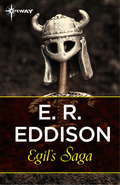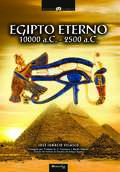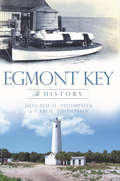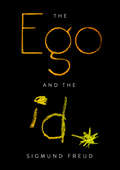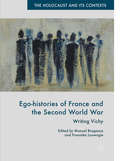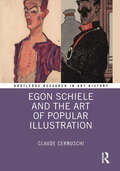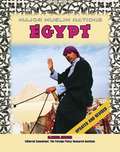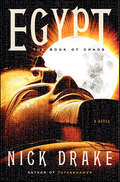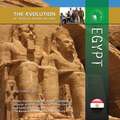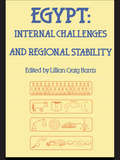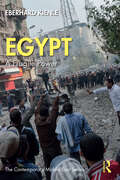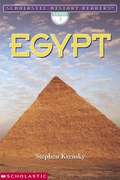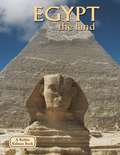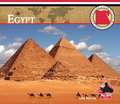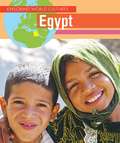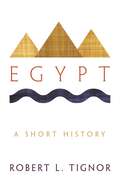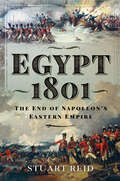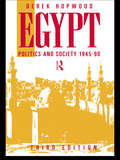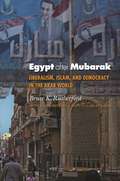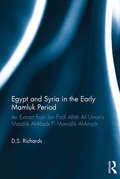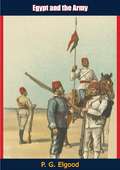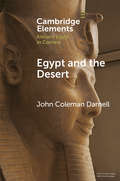- Table View
- List View
Egil's Saga
by E. R. EddisonEgil's Saga is the tale of the long and brutal life of Egil Skallagrimsson, the tenth-century warrior-poet: a morally ambiguous character who was both the composer of intricately beautiful poetry and a physical grotesque capable of staggering brutality. It recounts Egil's progression from youthful savagery to mature wisdom as he struggles to avenge his father's exile from Norway, defend his honour against the Norwegian King Erik Bloodaxe, and fight for the English King Athelstan in his battles against Scotland. Translated from Icelandic by the great fantasist, E R Eddison, and accounted by many to be the greatest of the Icelandic sagas, Egil's Saga is a fascinating depiction of a deeply human character.
Egil's Saga
by E. R. EddisonEgil's Saga is the tale of the long and brutal life of Egil Skallagrimsson, the tenth-century warrior-poet: a morally ambiguous character who was both the composer of intricately beautiful poetry and a physical grotesque capable of staggering brutality. It recounts Egil's progression from youthful savagery to mature wisdom as he struggles to avenge his father's exile from Norway, defend his honour against the Norwegian King Erik Bloodaxe, and fight for the English King Athelstan in his battles against Scotland. Translated from Icelandic by the great fantasist, E R Eddison, and accounted by many to be the greatest of the Icelandic sagas, Egil's Saga is a fascinating depiction of a deeply human character.
Egipto eterno, 10000 -2500 A.C. (Historia Incógnita)
by José Ignacio Velasco MontesUn recorrido visual por los orígenes de la cultura egipcia, con sus mitos, los Reyes-Dioses, las primeras dinastías, una época pretérita, legendaria que nos permitirá conocer a fondo la cultura más fascinante de la historia.
Egmont Key: A History (Brief History)
by Carol Thompson Donald H. ThompsonEgmont Key has been a sentinel for ships entering Tampa Bay from the Gulf of Mexico for hundreds of years. Early European explorers recognized the island's strategic location. Its story reflects major events in the history of the United States and Florida, as the island played a role in the Seminole Wars, the Civil War, the Spanish-American War and World Wars I and II. Its lighthouse, now automated, is still a beacon for ships. For many years, people have enjoyed the beaches of Egmont Key, walked the red brick "roads to nowhere" and explored the ruins of Fort Dade. Authors Don and Carol Thompson aim to foster an appreciation of the uniqueness and beauty of Egmont Key, as well as an understanding of its place in history.
The Ego and the Id (Complete Psychological Works Of Sigmund Freud Ser. #0)
by Sigmund FreudIn this seminal work of personality psychology, Austrian psychiatrist Sigmund Freud explains the dynamic of the human psyche with respect to the roles and conflicts produced by the id (the hidden source of human passion), ego (formed to negotiate the id's interactions with reality), and super-ego (the cricitcal, moralistic part of the mind); the latter two which remain in constant conflict with the id's demands. Freud further explores the concepts of the life force and the death force, and the anxieties driven by fear, morality, and guilt. This groundbreaking volume constitutes one of the Viennese physician's most insightful works on the topic. Penguin Random House Canada is proud to bring you classic works of literature and nonfiction in e-book form, with the highest quality production values. Find more today and rediscover books you never knew you loved.
Ego-histories of France and the Second World War: Writing Vichy (The\holocaust And Its Contexts Ser.)
by Manuel Bragança Fransiska LouwagieThis volume presents the intellectual autobiographies of fourteen leading scholars in the fields of history, literature, film and cultural studies who have dedicated a considerable part of their career to researching the history and memories of France during the Second World War. Basedin five different countries, Margaret Atack, Marc Dambre, Laurent Douzou, Hilary Footitt, Robert Gildea, Richard J. Golsan, Bertram M. Gordon, Christopher Lloyd, Colin Nettelbeck, Denis Peschanski, Renée Poznanski, Henry Rousso, Peter Tame, and Susan Rubin Suleiman have playeda crucial role in shaping and reshaping what has become a thought-provoking field of research. This volume, which also includes an interview with historian Robert O. Paxton, clarifies the rationales and driving forces behind their work and thus behind our current understanding of one of the darkest and most vividly remembered pages of history in contemporary France.
Egon Schiele and the Art of Popular Illustration (Routledge Research in Art History)
by Claude CernuschiPresenting a radically different picture of Egon Schiele’s work, this study documents (in one-to-one comparisons) the extent of the artist’s visual borrowings from the Viennese humoristic journal, Die Muskete. Claude Cernuschi analyzes each comparison on a case-by-case basis, primarily because the interpretation of cartoons and caricatures is highly contingent on their specific historical and cultural context. Although this connection has gone unnoticed in the literature, in retrospect, this correlation makes perfect sense. Not only was Schiele’s artistic production frequently compared to caricature (and derided for being “grotesque”), but Expressionism and caricature are natural allies. One may belong to “high” art and the other to “popular” culture, yet both presuppose similar assumptions and deploy a similar rhetorical position: namely, that the exaggeration of human physiognomy allows deeper psychological “truths” to emerge. The book will be of interest to scholars working in art history, visual culture, popular culture, and politics.
Egypt
by Clarissa AkroydNearly 5,000 years ago, on the eastern edge of the Sahara Desert, one of the world's earliest and greatest civilizations began to flourish. That civilization, Egypt, has held a firm grip on the human imagination ever since, with its powerful pharaohs, its awe-inspiring pyramids, and its mysterious religious beliefs. But Egypt is much more than a land of unsurpassed archaeological wonders. Today, it is the most populous Arab country; it was also the first Arab nation to make peace with Israel. As this ancient land struggles with the many problems of the 21st century, it remains a vital member of the global community. Discusses the geography, history, economy, government, religion, people, foreign relations, and major cities of Egypt.
Egypt: The Book of Chaos (Rahotep Series #3)
by Nick DrakeThe future ofEgypt lies in the hands of the Medjay’s chiefdetective Rahotep in the final, gripping installmentof Nick Drake’s acclaimed Ancient Egyptian trilogy. Following Nefertitiand Tutankhamun, Egypt: The Book of Chaos putsRahotep on a high-stakes adventure across enemyempires and rogue states on a top-secret mission to secure the fate of thedynasty. Readers of Stacy Schiff’s Cleopatraand anyone fascinated by ancient cultures and unspoken secrets will beinstantly drawn in by Drake’s magisterial recreation of one of history’s greatunsolved mysteries. Incorporating his own research through the sites,monuments, ruins, and museums of Egypt, Drake brings vividly back to life anera long ago swallowed by the shifting sands of time in this powerful novel ofloyalty, ambition, struggle, and destiny.
Egypt (The Evolution of Africa's Major Nations)
by William Mark HabeebThe Egyptian civilization along the Nile River was one of the ancient world's earliest and most influential empires. From pyramids to mummies to hieroglyphs, the unique and mysterious lore of this region in northeastern Africa still engages the imagination. While much has changed over the centuries, Egypt remains a fascinating place. Traditionally, Egypt's moderate political stance in the Arab world has given the country a strategic place on the world stage and made it a stabilizing force in the Middle East. However, in 2011 Egypt underwent a revolution that ousted longtime president Hosni Mubarak from power. Today, Egypt faces political and economic uncertainty, as its newly elected government attempts to rule under the country's new constitution.
Egypt: Internal Challenges and Regional Stability
by Lillian C HarrisKassem provides a concise and accessible introduction to Egypt, including chapters on domestic politics, foreign policy, economy and state formation. It will be of interest to anyone studying Egypt from a social science perspective.
Egypt: A Fragile Power (The Contemporary Middle East)
by Eberhard KienleFocusing on authoritarian rule, unresolved economic challenges, and external dependency, the volume explains the salient political and economic features of contemporary Egypt against the backdrop of its history since the beginning of the 19th century. Presenting a comprehensive account of developments, it challenges common assumptions about secularists, Islamists, and revolutionaries, as well as 'modernization', 'economic reform', and political stability. Discussing domestic politics, economic change, and external relations since 1945, the author argues that Egypt continued to draw a degree of strength from sustained state-building activities, which its pre-colonial rulers could pursue in a favourable international environment and the partly related emergence of the country as a focal point of collective identity. More consolidated than many other states in the global south, Arab and non-Arab alike, independent Egypt, despite changing economic strategies, remained a (lower) middle-income country and despite repeated political contestation, most recently in the Arab Spring, continued to suffer from autocratic rule. Such continuity reflects not only the interplay between political forces at home, dominated by the military, and inconclusive economic policies but also the external constraints under which governments and other actors in the global south have to act. Based on numerous primary and secondary sources in various languages, including Arabic, and years of fieldwork, the book is a key resource for scholars of all levels, journalists, policymakers, and diplomats interested in comparative politics and the political economy of the Middle East and Egypt.
Egypt (Scholastic History Reader™)
by Stephen KrenskyRead all about the secrets of ancient Egypt--from hieroglyphs to underground tombs. The Scholastic History Readers series was created especially to bring history to life for beginning readers.
Egypt: The Land (Lands, People and Cultures)
by Arlene MoscovitchEgypt is a land of timeless monuments and artifacts. It is also a land marked by the changes brought by the modern world; where camel drivers talk on cell phones and ancient tombs are moved to make way for modern dam building projects. With photographs, this work addresses the problems of pollution, global warming, and erosion on the land.
Egypt (Explore The Countries)
by Julie MurrayInformative, easy-to-read text and oversized scenic photos draw in readers as they journey through Egypt home of the mighty Nile River, the magnificent Great Sphinx and Pyramids of Giza, and the tomb of King Tut. Readers will learn about Egypt s history, government, major cities, land features, natural resources, culture, and more! Maps, a timeline with photos, fun facts, and pronunciation guides aid readers. The book closes with a facts page including Egypt s population and total area, as well as images of the Egyptian flag and currency. Students will find valuable report information while exploring Egypt! Table of contents, glossary, and index included. Aligned to Common Core Standards and correlated to state standards. Big Buddy BOOKS is an imprint of ABDO Publishing Company.
Egypt (Exploring World Cultures Series)
by Kate ShoupEgypt is a country that has existed for many centuries. It is a land of pyramids, pharaohs, and history. This book examines the many areas that make up Egypt, such as geography, food, sports, and traditions. It is written clearly and in an easy-to-read manner. It connects young readers to the text by using photographs and vocabulary.
Egypt: A Short History
by Robert L. TignorA sweeping and colorful account of Egypt’s 5000-year historyThis is a sweeping, colorful, and concise narrative history of Egypt from the beginning of human settlement in the Nile River valley 5000 years ago to the present day. Accessible, authoritative, and richly illustrated, this is an ideal introduction and guide to Egypt's long, brilliant, and complex history for general readers, tourists, and anyone else who wants a better understanding of this vibrant and fascinating country, one that has played a central role in world history for millennia—and that continues to do so today.Respected historian Robert Tignor, who has lived in Egypt at different times over the course of five decades, covers all the major eras of the country's ancient, modern, and recent history. A cradle of civilization, ancient Egypt developed a unique and influential culture that featured a centralized monarchy, sophisticated art and technology, and monumental architecture in the form of pyramids and temples. But the great age of the pharaohs is just the beginning of the story and Egypt: A Short History also gives a rich account of the tumultuous history that followed—from Greek and Roman conquests, the rise of Christianity, Arab-Muslim triumph, and Egypt's incorporation into powerful Islamic empires to Napoleon's 1798 invasion, the country's absorption into the British Empire, and modern, postcolonial Egypt under Nasser, Sadat, and Mubarak.This book provides an indispensable key to Egypt in all its layers—ancient and modern, Greek and Roman, and Christian and Islamic. In a new afterword the author analyzes the recent unrest in Egypt and weighs in on what the country might look like after Mubarak.
Egypt: Mass Arrests and Torture in Sinai
by Human Rights WatchOn October 7, 2004, a massive car-bomb wrecked the Taba Hilton hotel located on the Egyptian-Israeli border. There were two smaller bombings later that night at nearby tourist campsites. The attacks killed more than thirty and wounded more than one hundred. Most of the victims were tourists, many of them Israelis, as well as Egyptian hotel staff. Initial speculation by Egyptian and Israeli authorities focused on al-Qaeda or other international groups that have carried out large-scale attacks against civilians. But just over two weeks later, on October 25, Egypt's Ministry of Interior announced that it had identified nine persons responsible for the attacks, all from the North Sinai area: five were in custody, two had been killed carrying out the attack, and two remained at large. Meanwhile, around October 13, Egypt's State Security Investigation service (SSI) began a campaign of mass arbitrary arrests in and around al-`Arish, the government and commercial center of North Sinai, apparently as part of its investigation into the Taba attacks. These arrests continued unabated after the October 25 announcement through early December. Egyptian human rights groups said that security forces had rounded up as many as three thousand persons, including several hundred persons detained solely to secure the surrender of wanted family members.
Egypt: Security Forces Abuse of Anti-War Demonstrators
by Human Rights WatchThis report documents serious human rights violations by Egyptian security officials during and following large demonstrations in Cairo on March 20 and 21, 2003 against the U.S.-led war in Iraq. These violations included: excessive use of force in disbursing demonstrators and bystanders on March 21 in violation of the right to freedom of assembly; arbitrary arrest and detention, including of children; beatings and mistreatment of persons in detention, in some cases amounting to torture; and failure to provide medical care to seriously injured detainees.
Egypt 1801: The End of Napoleon's Eastern Empire
by Stuart ReidThe first campaign medal awarded to British soldiers is reckoned to be that given to those men who fought at Waterloo in 1815, but a decade and a half earlier a group of regiments were awarded a unique badge – a figure of a Sphinx - to mark their service in Egypt in 1801. It was a fitting distinction, for the successful campaign was a remarkable one, fought far from home by a British army which had so far not distinguished itself in battle against Revolutionary France, and one moreover which had the most profound consequences in the Napoleonic wars to come. In 1798 a quixotic French expedition led by a certain General Bonaparte not only to seize Egypt and consolidate French influence in the Mediterranean, but also to open up a direct route to Indian and provide an opportunity to destroy the East India Company and fatally weaken Great Britain. In the event, General Bonaparte returned to France to mount a coup which would eventually see him installed as Emperor of the French, but behind him he abandoned his army, which remained in control of Egypt, still posing a possible threat to the East India Company, until in 1801 a large but rather heterogeneous British Army led by Sir Ralph Abercrombie landed and in a series of hard-fought battles utterly defeated the French. Not only did this campaign establish the hitherto rather doubtful reputation of the British Army, and help secure India, but its capture en route of the islands of Malta gained Britain a base which would enable it to dominate the Mediterranean for the next century and a half. This little understood, but profoundly important campaign at last receives the treatment it deserves in the hands of renowned historian Stuart Reid.
Egypt 1945-1990: Politics and Society
by Derek HopwoodFirst published in 1991. Routledge is an imprint of Taylor & Francis, an informa company.
Egypt after Mubarak: Liberalism, Islam, and Democracy in the Arab World (Princeton Studies in Muslim Politics #48)
by Bruce K. RutherfordWhich way will Egypt go now that Husni Mubarak's authoritarian regime has been swept from power? Will it become an Islamic theocracy similar to Iran? Will it embrace Western-style liberalism and democracy? Egypt after Mubarak reveals that Egypt's secularists and Islamists may yet navigate a middle path that results in a uniquely Islamic form of liberalism and, perhaps, democracy. Bruce Rutherford draws on in-depth interviews with Egyptian judges, lawyers, Islamic activists, politicians, and businesspeople. He utilizes major court rulings, political documents of the Muslim Brotherhood, and the writings of Egypt's leading contemporary Islamic thinkers. Rutherford demonstrates that, in post-Mubarak Egypt, progress toward liberalism and democracy is likely to be slow. Essential reading on a subject of global importance, this edition includes a new introduction by Rutherford that takes stock of the Arab Spring and the Muslim Brotherhood's victories in the 2011-2012 elections.
Egypt and Syria in the Early Mamluk Period: An Extract from Ibn Faḍl Allāh Al-‘Umarī's Masālik Al-Abṣār Fī Mamālik Al-Amṣār
by D.S. RichardsProviding a modern English translation of a key selection of Ibn Fadl Allah al-`Umarī’s Masālik al-absār, this book offers a rich description of Egypt and Syria under the Mamluks in the first half of the fourteenth-century A.D. It provides a fascinating snapshot of the physical and administrative geography of this crucial region as well as insights into its society and the organization and functioning of the Mamluk state.
Egypt and the Army
by P. G. ElgoodIn his 1924 book, Egypt and the Army, author P. G. Elgood demonstrated his intimate knowledge and reasoned criticism of the conditions and circumstances which brought the Egyptian Army into being from 1882 onwards, and resulted in the creation of a reliable fighting force when trained and disciplined by carefully selected British officers.An invaluable addition to any History library.
Egypt and the Desert (Elements in Ancient Egypt in Context)
by John Coleman DarnellDeserts, the Red Land, bracket the narrow strip of alluvial Black Land that borders the Nile. Networks of desert roads ascended to the high desert from the Nile Valley, providing access to the mineral wealth and Red Sea ports of the Eastern Desert, the oasis depressions and trade networks of the Western Desert. A historical perspective from the Predynastic through the Roman Periods highlights how developments in the Nile Valley altered the Egyptian administration and exploitation of the deserts. For the ancient Egyptians, the deserts were a living landscape, and at numerous points along the desert roads, the ancient Egyptians employed rock art and rock inscriptions to create and mark places. Such sites provide considerable evidence for the origin of writing in northeast Africa, the religious significance of the desert and expressions of personal piety, and the development of the early alphabet.
